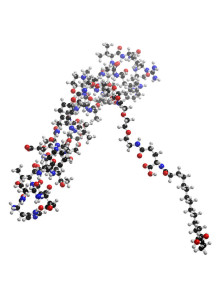Semaglutide
a medication that belongs to a class of drugs known as GLP-1 receptor agonists (glucagon-like peptide-1 receptor agonists). It is primarily used to manage type 2 diabetes but also has indications for weight management
Peptide Purity (HPLC 85% Minimum, 95% Typical). Can only be used for research.
a medication that belongs to a class of drugs known as GLP-1 receptor agonists (glucagon-like peptide-1 receptor agonists). It is primarily used to manage type 2 diabetes but also has indications for weight management
Peptide Purity (HPLC 85% Minimum, 95% Typical). Can only be used for research.
Semaglutide is a medication that belongs to a class of drugs known as GLP-1 receptor agonists (glucagon-like peptide-1 receptor agonists). It is primarily used to manage type 2 diabetes but also has indications for weight management.
Mechanism of Action
Semaglutide works by mimicking the action of GLP-1, a hormone that increases insulin secretion in response to meals. It has several effects:
Increases Insulin Secretion: Helps lower blood sugar levels post meals.
Suppresses Glucagon Secretion: Reduces the release of glucose from the liver.
Slows Gastric Emptying: Promotes a feeling of fullness, which can help with weight loss.
Appetite Suppression: Reduces appetite, leading to lower calorie intake.
Indications
Type 2 Diabetes: Helps improve blood sugar control when used along with diet and exercise.
Obesity and Weight Management: Approved for chronic weight management in adults with obesity or overweight with at least one weight-related condition (e.g., hypertension, type 2 diabetes).
Semaglutide is available in two forms:
Injectable: Usually administered once weekly. Brand names include Ozempic (for diabetes) and Wegovy (for weight management).
Oral: A daily tablet form under the brand name Rybelsus for type 2 diabetes.
Efficacy
Studies have shown that semaglutide is effective in:
Significantly lowering HbA1c levels (a measure of blood sugar control).
Promoting weight loss. Patients can lose a significant amount of body weight over a period of treatment.
Side Effects
Common side effects include:
Nausea
Vomiting
Diarrhea
Abdominal pain
These side effects are usually mild to moderate and tend to decrease over time.
Precautions
Pancreatitis: There is a potential risk of pancreatitis. Patients should be monitored for symptoms.
Thyroid Tumors: In rodent studies, GLP-1 receptor agonists have been associated with an increased risk of thyroid tumors. The relevance of this finding to humans is unknown, but it is a point of caution.
Renal Function: Caution in patients with renal impairment.
Benefits Beyond Glycemic Control
Apart from glycemic control and weight loss, semaglutide has shown cardiovascular benefits. It can reduce the risk of major adverse cardiovascular events (MACE) in patients with type 2 diabetes and established cardiovascular disease
For Oral Formulation, Salcaprozate Sodium (SNAC) is required to stabilize and help increase the absorption of Semaglutide
| Mechanism | - |
| Appearance | - |
| Longevity | - |
| Strength | - |
| Storage | - |
| Shelf Life | - |
| Allergen(s) | - |
| Dosage (Range) | - |
| Recommended Dosage | - |
| Dosage (Per Day) | - |
| Recommended Dosage (Per Day) | - |
| Mix Method | - |
| Heat Resistance | - |
| Stable in pH range | - |
| Solubility | - |
| Product Types | - |
| INCI | - |
Purchase History for
Cart
No products



